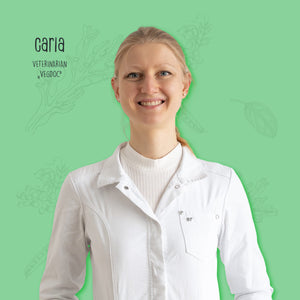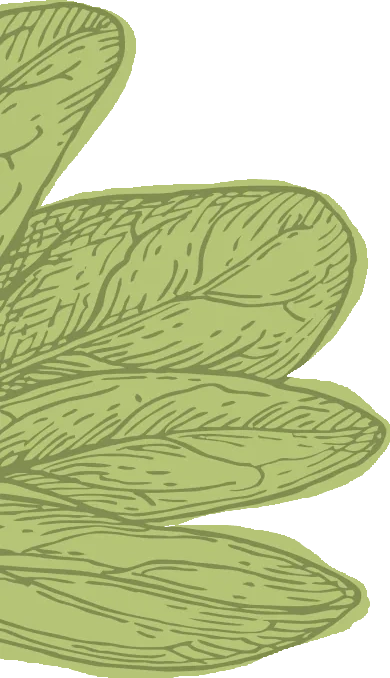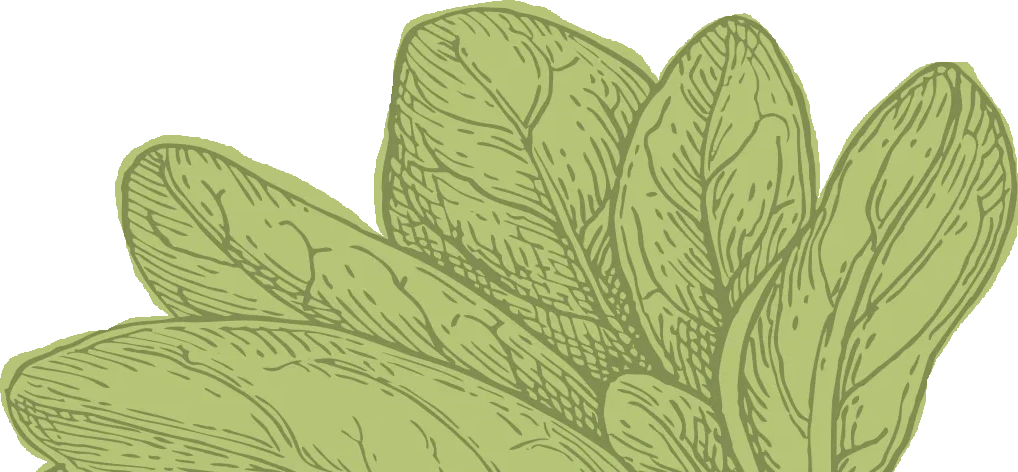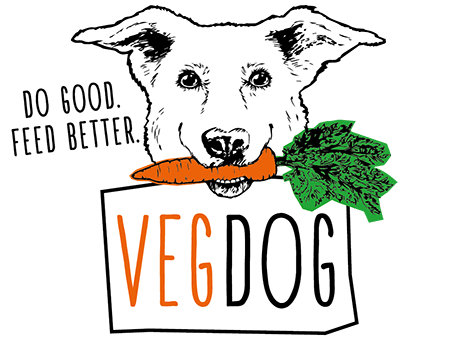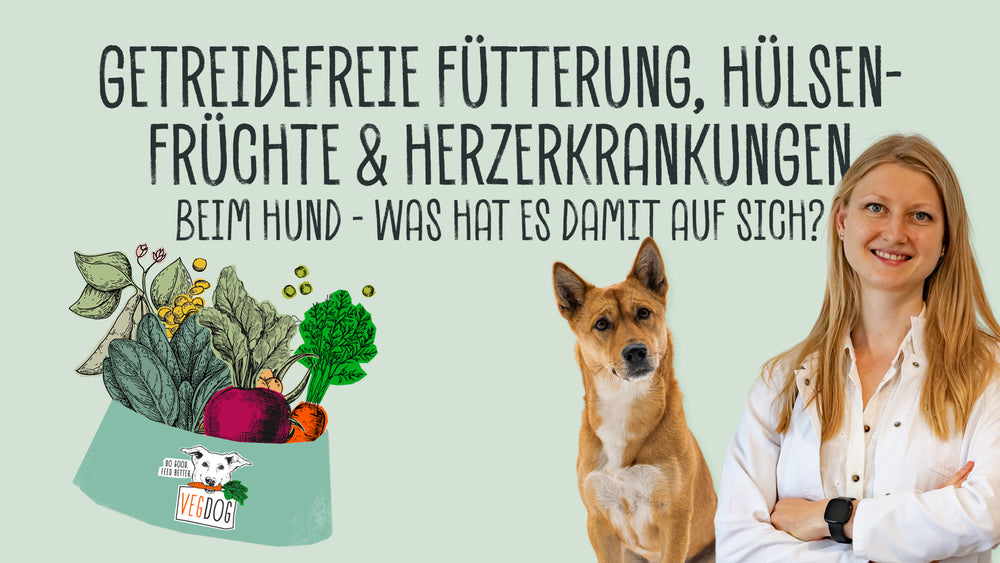
Grain-free feeding, legumes and heart disease in dogs.
For some time now, there have been increasing reports that a certain form of chronic heart disease (DCM) in dogs occurs more frequently with certain feeding regimes than with others.
 Author: Carla Steffen
Author: Carla Steffen
 Proofreader: Veronika Hajek
Proofreader: Veronika Hajek
Updated: 01.10.2024
Published: 10.06.2024
For some time now, there have been increasing reports that a certain form of chronic heart disease in dogs, known as dilated cardiomyopathy (DCM for short), is more common with certain types of feeding than with others. Some studies suspect a possible connection between grain-free or legume-containing feeding and the development of DCM[1]. Since legumes are an important component of vegan complete feed and therefore also of our own products, we have also been following the issue from the beginning. This article provides a brief overview of the current findings:
A brief summary of the current state of knowledge:
- DCM cases also occurred with grain-containing/legume-free feeding
- DCM cases did not occur in all grain-free/legume-containing diets, possibly depending on the manufacturer/composition: the nutrient contents are not always checked, not all complete feeds cover the needs
- When comparing grain-free dog food, special attention should be paid to the ingredients
- The question of grain-free wet or dry food must be dealt with individually
Initial investigations
After the US Food and Drug Administration (FDA) received reports of increasing numbers of DCM cases in dogs, an extensive investigation into the issue was carried out: data was collected nationally and internationally. In particular, case reports from veterinary practices and the type of feeding given to the patient were evaluated.
In an initial statement in June 2018, the FDA stated that not all grain-free or legume-containing foods are associated with an increased risk of DCM. For example, not all dogs that had been fed a "grain-free diet" developed cases of DCM. This was attributed to the fact that these manufacturers have the necessary know-how in the design of complete foods - in other words, that these grain-free complete foods, in which no cases occurred, met the needs. [2]
Grain-free dog food with a high meat content…
In the same FDA statement, there seemed to be no difference whether the dogs were fed a meat-based, vegetarian or vegan diet: For example, the majority of cases of DCM occurred on the combination diet of lamb and rice - i.e. neither legume-containing nor grain-free. So the question remains whether the ingredients themselves are actually responsible or whether a lack of certain essential nutrients is causing the problem (e.g. methionine and cysteine or taurine).[2]
Current Development
Further studies and a recently updated FDA statement[3] still do not allow a conclusive statement about a possible connection between grain-free/legume-containing feeding and the occurrence of DCM. Although the market share of grain-free commercial feeds increased by approximately 500% between 2011 and 2019[4,5], the number of cases of patients with DCM only showed a slight increase[6]. Furthermore, the FDA states in its current statement that this form of heart disease also occurred in dogs fed grain-containing food. The FDA cannot therefore confirm a definitive connection between grain-free feeding and the occurrence of DCM to date.
Grain-free dog food in the test:
When looking for the right dog food, you often come across comparison sites that list dog food without grains. Such comparison sites often spread nutritional myths, such as that the pure meat content is crucial for the furry friend's protein supply. Therefore, we give you some know-how on what you should look out for when comparing dog food:
When comparing dog food, pay particular attention to the ingredients. High-quality oils, fruit or herbs are also often an indication of high-quality dog food. This means that vitamins, minerals and fatty acids are added to the dog food. VEGDOG pays attention to high-quality ingredients and a balanced diet in dog food such as GREEN CRUNCH .
Wet or dry food?
When comparing grain-free dog food, the question also arises as to whether it is wet or dry food. The differences between grain-free wet and dry food lie primarily in the water content. Wet food can consist of up to 84% water, while dry food only contains 3-12%. This means that wet food can spoil more quickly than dry food. With dry food, care should be taken to ensure that your dog drinks enough. For dogs that drink very little, wet food may therefore be the better choice.
Due to the low water content, less food is needed to achieve the necessary energy in dry food. Overweight dogs should therefore be fed wet food, as the food has a higher water content and therefore keeps your four-legged friend full. Both wet and dry food should be stored in a cool, dry place .
Which food should ultimately be chosen depends on the individual furry friend. Dry food is often more practical and cheaper, but if the four-legged friend has one or two kilos too much on its ribs, it may be better to use wet food. Even if the furry friend drinks little, wet food is the better alternative.
Conclusion
In order to understand possible connections and causes between diet and the occurrence of DCM, further studies are desirable and necessary. It is therefore welcome that increasing focus is being placed on this topic. If certain ingredients in certain processing forms have undesirable effects on the availability of nutrients, these are important findings that must be taken into account when putting together a complete feed.
When comparing grain-free dog food, particular attention should be paid to the ingredients. Of course, we also follow the latest results and take these into account in our product development. For this reason, we pay particular attention to the supply of all essential nutrients, including methionine, cysteine and taurine, and check the nutrient content using laboratory analyses.
Sources
[1] Owens, E.J. et al. (2023). Comparison of echocardiographic measurements and cardiac biomarkers in healthy dogs eating nontraditional or traditional diets. J. Vet. Inter. Med. 37(1):37-46.
[2]Wilfredo DM et al. (2019). Special topic: The association between pulse ingredients and canine dilated cardiomyopathy: addressing the knowledge gaps before establishing causation. J.Anim. Sci. 1;97(3)
[3]FDA: https://www.fda.gov/animal-veterinary/outbreaks-and-advisories/fda-investigation-potential-link-between-certain-diets-and-canine-dilated-cardiomyopathy
[4]The Nielsen Company (2020a). Grain Free Dollars Sales Trend (Report ID RB01) [Nielsen Answers]. New York, NY: The Nielsen Company.
[5]The Nielsen Company (2020b). Extended All Outlet Combined (xAOC) and Pet Specialty. Dollar volume and share, total pet food and dry dog food, regular and grain-free [Nielsen Answers]. New York, NY: The Nielsen Company.
[6]Quest, BW et al. (2020). Incidence of Canine Dilated Cardiomyopathy Diagnosed at Referral Institutes and Grain-Free Pet Food Store Sales: A Retrospective Survey. Front. Vet. Sci. 3
Frequently Asked Questions (FAQ)
Does grain-free puppy food make sense?
Grain is a strong source of energy that can cover the particularly high energy needs of puppies. If the little furball tolerates the grain, the protein source can be supportive during the growth phase.
Is grain-free dog food appropriate for seniors?
Just like us, our furry friends lose muscle mass and often gain fat mass as they get older. Since older four-legged friends also move less than younger ones, they have a lower energy requirement than younger four-legged friends. The right ratio of energy to nutrient requirements is particularly important when feeding seniors. Proteins, carbohydrates and fats should be in the optimal ratio to one another, be highly digestible and easily digestible. A grain-reduced diet is therefore recommended, using high-quality grains such as millet. VEGDOG has therefore developed SENIOR PEAS & MILLET to ensure a balanced diet for older furry friends.
What should you look for on comparison sites?
Comparison sites often spread nutritional myths that are no longer relevant. So pay attention to the ingredients in dog food. No sugar should be added and vegetables should be used instead of grains, for example. High-quality oils, fruit or herbs can also be indicators of high-quality dog food.

